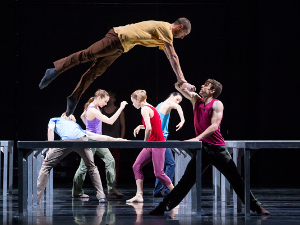The Eastern Music Festival is back and sounding better than ever. The vagaries and vicissitudes of a world and nation healing themselves of the pandemic begin to fade while we return from isolation to interaction, and from the solitude of the practice room to the solidarity of the concert hall. Masks and social distancing for the audience are still de rigueur although the musicians on stage now share music stands and sit in their normal places. (Vaccination and proof of health is obligatory for the employees, faculty, and students participating in EMF this year.)
Although EMF’s precautionary measures include a somewhat restricted student enrollment and personnel, they have had no effect on the quality of the performances and musical offerings. A prime example of this was the outstanding Brahms Piano Concerto, Op. 15, brought to the public by William Wolfram and the Eastern Music Festival Orchestra under the direction of Gerard Schwarz, who is now in his 17th year as EMF’s music director.
The first half of the sumptuous musical banquet presented by the Eastern Music Festival’s imaginative maestro consisted of a dozen and a half musical miniatures, served seamlessly in an increasingly complex suite of hors d’oeuvres, amuse-gueules and ending in a veritable feast for chefs and orchestra.
The first eight miniature pieces were originally composed over a period of five years (1912-1917) by Igor Stravinsky for piano 4-hands, intended to be played by Stravinsky’s children, Theodore and Mika – with Papa playing the more complicated left hand. Stravinsky later orchestrated the eight pieces for orchestra and divided them into two Suites for Small Orchestra.
Some exciting moments were provided in the Napolitana where we could hear the famous “faniculì, faniculà,” and in the Valse where flute and piccolo reminded us vividly of similar moments in the ballet Petruschka. Clever orchestration has always been a hallmark of Stravinsky, and his use of the tuba as a melodic instrument in the Polka and a pair of blaring clarinets trying to imitate the “paahn-poohn” of a passing ambulance were good reminders. Schwarz adroitly manipulated the audience to hold its applause until the end of the 10-minute combined suites. How nice and how unusual to hear new pieces from familiar composers, especially in a festival setting!
The same can be said of Richard Strauss, whose more familiar tone poems (Till Eulenspiegel, Don Juan, Tod und Verklärung [Death and Transfiguration], Also spracht Zarathustra, Don Quixote and Ein Heldenleben) form a significant part of “Festival” repertory. Not so, the Suite from Le Bourgeois Gentilhomme, which originally began as a collaboration with Hugo von Hofmannsthal. Together, they attempted to update and translate into German Molière’s classic comédie-ballet for a contemporary audience. The disastrous result was a six and a half hour play partnered with an opera for the last hour and a half. Strauss decided to separate out the opera, which became Ariadne auf Naxos, and to create a half-hour suite in nine parts (heard on this program) with his new music. Von Hofmannsthal’s portions were published in a separate form. (Click here to view the distinction from the desk of Boosey and Hawkes, the publisher of all four versions!)
This was a splendid performance with especially lovely solos from concertmaster Jeff Multer, principal cellist Neal Cary, hornists Kevin Reid and Joy Branagan, and bass trombone player Michael Kris. The entire orchestra, with the string section augmented discreetly, was especially colorful in the longer closing dinner sequence where one could hear bleating sheep (Strauss quoting himself) and Strauss quoting Verdi (“Woman is fickle…”), all in the context of a dinner party where the wife and daughter triumph over the social-climbing pretenses of the husband, the would-be gentleman.
Young Johannes Brahms was 21 years old when he presented the first version of his Opus 15 concerto to Clara Schumann as a sonata for two pianos. Another version saw the first movement orchestrated as a symphony, but by 1856, Brahms had made up his mind and completed the work as a concerto in three movements. The massive first movement bears comparison with the first movement of Beethoven’s Ninth Symphony, harmonically and structurally: both are in the key of D minor with major incursions into the key of B-flat Major, and each presents its brooding dramatic first theme in the first inversion of the chord (B-flat Major over “D” pedal for Brahms and D Major over F-sharp pedal for Beethoven).
The 21-minute first movement demands much from a soloist, and Wolfram gave amply – power in the first movement and serenity in the second movement. The third movement (Rondo) is again in D minor, but without the tragic sense of the first movement. The cadenza leads us into a sunnier D Major, and at the meno mosso, a rollicking tune in sixths seems to dissipate any remnant of the first movement’s D minor gloom. The audience gave soloist Wolfram a well-deserved standing ovation!
There are faculty and student concerts almost daily during the entire month of July; see sidebar for program details.











